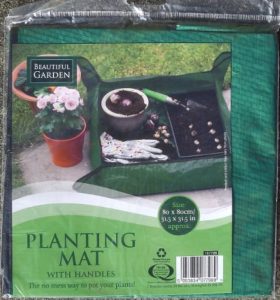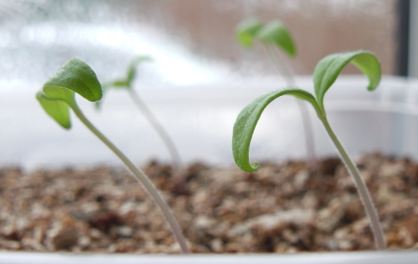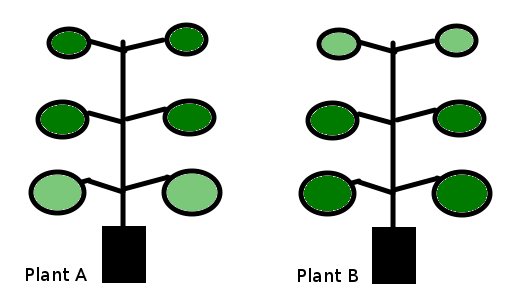Each season I sow tomato seeds early in order to take photos for the newsletter and website – that’s my excuse anyway!
I find that seeds taken from my own tomatoes the season before, are always more vigorous than bought seeds. Saving seeds from your own tomatoes also means that you know exactly what you are going to get when they fruit.
Supermarket Tomatoes and Seeds
It is possible to save the seeds of supermarket tomatoes. The value ones aren’t worth growing – they just have a long shelf life and no taste. Those on the vine are the ones to save, especially the smaller varieties like Piccolo and Sunstream.
Also check out the country of origin, if it is Spain or Israel, the variety probably needs the same temperatures that would be found there, so go for a British grown tom.
Piccolo and Sunstream are professional varieties that need consistent growing conditions to do well – best grown in a greenhouse or tunnel.
Germination Times
At around 20c in an electric propagator with a thermostat, it takes five or six days for germination.
In the airing cupboard, where temperatures are warm during the day and cooler at night, it takes six or seven days. For the sake of one day, it’s less expensive in the airing cupboard!
By germinating seeds at the same temperatures means that you’ll know how long they’ll take to germinate.
Some varieties take longer to germinate than others – a good reason to keep varieties in separate seed trays.
Useful Item
 On another visit to Poundland (I can’t seem to stay out of that shop) I found the planting mat that Rhys mentioned in the comments of last week’s newsletter. It makes a small but effective portable potting mat – just right for filling a seed tray or a few small pots without making a mess.
On another visit to Poundland (I can’t seem to stay out of that shop) I found the planting mat that Rhys mentioned in the comments of last week’s newsletter. It makes a small but effective portable potting mat – just right for filling a seed tray or a few small pots without making a mess.
Check out the other many useful items for a pound!
Their large pots are good value too.
Plant Hormones
Hormones coordinate growth. They send a message from one part of a plant to another, to tell cells to do something.
For example, a seedling leans towards the light.
This happens because the hormone auxin is sent from the tip, down the shade side of the stem which elongates the cells on that side.

Because the cells are elongated on the shade side of the stem, and not the light side of the stem, the seedling leans or bends towards the light.
Auxin is also used to promote rooting activity so it’s the stuff gardeners use when taking cuttings by dipping the stem in the rooting powder or gel. I contacted the makers of Rootit rooting gel to ask about the hormone levels in their gel. They said that their rooting gel contains less hormone than is in the plant already – that’s good!
Auxin also helps when grafting too!
How to tell which nutrient a plant needs when leaves show the same symptoms!
Nutrient Mobility and Translocation
Some nutrients are considered mobile and some immobile.
Nitrogen, for example, moves around a plant’s system quickly – because nitrogen is mobile. Calcium on the other hand, is immobile and does not move from one part of a plant to another, once it gets into a plants system it stays in that area.
If top leaves need more nitrogen than is being supplied by the roots, the top leaves will take the extra nitrogen they need from the lower leaves.
So if the lower leaves are turning pale and look as if they are in need of a good feed (plant A), it is probably because the top growth has taken their nitrogen!
Magnesium is also mobile and is regularly moved from the lower to the upper leaves if required.
However, when top leaves are pale and lower leaves are ok (plant B), it cannot be a nitrogen or magnesium shortage. If it were, the top leaves would have removed them from the lower leaves.

So, when top leaves are pale (plant B), it is most likely an immobile nutrient that is deficient.
Calcium is immobile and that is why we have so much Blossom End Rot in fruit. A slight shortage of Calcium when the tomatoes are forming will cause BER.
Calcium deficiency also shows as stunted new growth at the growing tip.
To a lesser extent iron (semi-mobile) will also show as a deficiency in the top leaves. Pale yellow/green leaves around the growing tip is likely to be an iron shortage.
Interruption
Every time nutrient intake (and moisture) through the roots slows or stops, means that the flow of immobile nutrients such as calcium and iron are interrupted and a deficiency is likely to occur.
This is one very good reason why having nutrients available 24/7, by way of water reservoirs etc., is the better way to grow tomatoes.
Temperatures, nutrient balance in the soil and pH also play their role. However, if a plant starts off healthy then shows leaf symptoms as described above, it can be quickly diagnosed and a foliar spray applied.
That’s it for this week – I know that some of you have already started sowing, so if you have, I hope your seedlings are doing well!
Regards,
Nick
PS Comments welcome as always below.
It’s always a good idea to sow varieties that are popular such as Gardener’s Delight and Moneymaker. They are popular for a good reason, that is, they are reliable and most likely to succeed.
If you are new, or not so new to growing tomatoes, growing the larger varieties takes more experience and requires a good summer!
Timing is also an issue. Sow too soon and plants struggle through poor conditions. Sow too late and tomatoes won’t be ripe before the weather turns colder in the autumn. March to April is ideal.


Lauren
Thoughts on Stupice? I will be growing it in a greenhouse. Does growing toms in pots on grow bags make much difference compared to growing in just the grow bags?
Nick
Hi Lauren,
I’ve grown Stupice outside with mixed results but didn’t find it earlier or more cold tolerant than several other popular varieties. Glacier, Alaskan Fancy, Siberian, Oregon Spring and many of the black varieties are worth trying if you are after an early fruiter. However, the only way to find out is to grow it in your garden.
I find that using pots on grow bags (or grow pots) improves results. It increases the soil depth and quantity and allows for feeding inside the pot (minimum moisture) and watering outside of the pot away from the stem base. By raising the stem base also increases air flow.
Nick
Mark
Thanks again for the very informative newsletter. I love the way you break down and explain this (often complex) stuff clearly and simply.
My question: can tomato plants get a deficiency in calcium in times of persistent and bad wind conditions? I ask because I was growing some tomatoes on a window sill a few years back and despite being in containers with (big!) water reservoirs, in new compost, and being fed regularly, some of the tomatoes got BER. My hypothesis at the time was that the persistent winds might have had an affect on the plants ability to take up nutrients – but I’ve little idea whether this might correct.
Mark
Nick
Hi Mark,
Although the windy conditions may have cause some stress, the extra air flow would have increased transpiration and would probably have helped avoid BER rather than caused it.
I think the answer lies elsewhere … nutrient balance or temperature related maybe.
Nick
Michael Johnson
Hi-Nick, the only problem with saving seeds from (Piccolo) is that it is an F1 hybrid, and when you save the seeds and try to grow them, the resulting seedlings split into two separate groups, it is a segregate , one is similar to the normal Piccolo but not quite as strong a flavour, the second segregate is a pale almost tasteless variety of no real value, if one tries to de-hybridise them you eventually end up with a weaker flavoured version of Piccolo.
Michael Johnson – Moderator of the potato leaf section- of the forum- (Tomato Depot) situated in the USA, but now with over 1,000 members from all over the world, of which I am one of them 🙂 there are several English people like myself there, and we are always looking for new members, there are some well known personalities there including myself, also Dr, Marvin Meisener, author of the book-(how to grow giant tomatoes) as well as many of the current champion giant tomato growers turning out six and seven pound tomatoes, Potato leaf tomatoes section , and lots of other sections, a very good seed exchange section with thousands of new tomatoes and promising crosses, all are very welcome, they are a very friendly group, I also invite (Nick )to join-just mention my name as an introduction and you are in 🙂 sign up and become a member.
Nick
Hi Michael,
Thanks for the info. I think there is some confusion in tomato circles over whether Piccolo is an open pollinated or hybrid. http://store.tomatofest.com/Piccolo_Tomato_Seeds_p/tf-0380h.htm A few seasons ago there was a similar confusion over Tumbling Tom.
Thanks for the invitation.
Nick
Michael Johnson
Hi-Nick, funnily enough- the seeds that the tomatofest chap is using as Piccolo, are originally from seeds I sent to a friend of his called (Laurel) five or six years ago, as a de-hybridized version, which I de-hybridized myself,she in turn gave some to him-which he now calls Piccolo, they are not quite as strong in flavour as the real thing.
All supermarket type Piccolo are actual hybrids from either Italy or Spain, and will segregate into two types of segregate. the main problem is- that you cannot tell they are segregates until the tomatoes begin to ripen on the vine, as both types look almost identical in shape and form as they are growing, it is only when they begin to ripen that the difference begins to show itself in the form of one type is red and normal looking, the other is very pale and quite different and not nearly as tasty.
Derek Warren
Hi Nick,
I’ve never saved my tomato seeds for growing on the following year, I grow mainly Gardeners Delight & Moneymaker, what in your opinion is the best way to save them.
Regards, Derek
Nick
Hi Derek,
Here’s a link to a useful page: https://www.tomatogrowing.co.uk/html/tips-for-saving-tomato-seeds.html
Regards,
Nick
Mark
Hi Derek, I recently filmed Peter Brinch, expert biodynamic grower and seed saver on how to save tomato seeds – you can see it here: http://www.verticalveg.org.uk/how-to-save-tomato-seeds/
Nick, is it OK to put that link up on here? Please delete if not.
Many thanks
Mark
paul
hello nick,
I would like to grow tomato plants in pots out side.
can you recomend any?
thanks for your newsletter and time.
Nick
Hi Paul,
Have a go at a few bush varieties such as Maskotka and Red Alert, they do very well outside in large pots.
Nick
kevin
Hi Nick this year I am growing F1 Orkado, Heartbreaker Vita F1, Ailsa Craig,and Alicante.
Nick
Hi Kevin,
I haven’t grown Heartbreaker – let us know how it goes. Orkado F1, Ailsa Craig and Alicante are very similar in size – it will be interesting to compare their taste.
Nick
Nigel Davies
Grew Heartbreaker and Orkado last year both done very well , will be growing again this year .
Uploaded some pictures on Tomataville last year of Heartbreaker and a few links .
You will have to goin to view pictures i think , its free so no probs .
Nigel .
Nick
Thanks Nigel, I’ll take a look at your pictures.
Nick